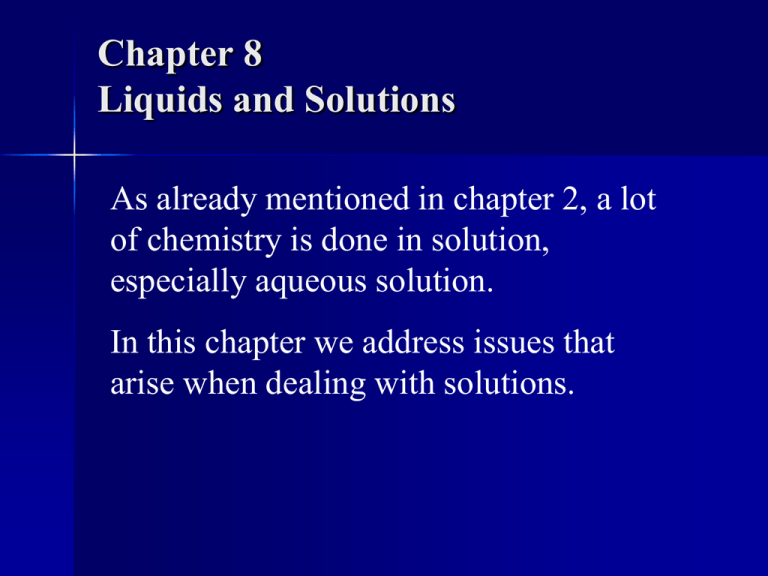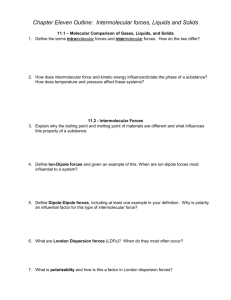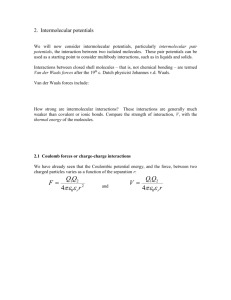Intermolecular Forces
advertisement

Chapter 8
Liquids and Solutions
As already mentioned in chapter 2, a lot
of chemistry is done in solution,
especially aqueous solution.
In this chapter we address issues that
arise when dealing with solutions.
The Structure of Gases, Liquids and
Solids
Figure 8.1
The Structure of Gases, Liquids and
Solids
Table 8.1
The Structure of Gases, Liquids and
Solids
●
●
Intramolecular bond
Intermolecular force
Figure 8.2
Intermolecular Forces
●
●
●
Absent in kinetic molecular theory.
In their absence, all matter is in the gas
phase.
Relative strength of intermolecular forces
established using boiling points.
Low bp means weak intermolecular forces.
High bp means strong intermolecular forces.
Intermolecular Forces
Five important types
dipole-dipole
dipole-induced dipole
induced dipole-induced dipole
van der Waals (aka London, dispersion)
Hydrogen bonding
Intermolecular Forces
●
dipole-dipole
Figure 8.3
Intermolecular Forces
●
dipole-induced dipole
Figure 8.4
Intermolecular Forces
●
induced dipole-induced dipole
Figure 8.5
Intermolecular Forces
●
van der Waals
Weak
Present in all systems.
Proportional to the number of electrons in the
molecules.
Table 8.2
Intermolecular Forces
●
van der Waals
MW, Figure 8.8
Shape, Figure 8.7
–
Figure 8.7
n-pentane (bp 36.1 ⁰C) vs
neopentane (bp 9.5 ⁰C)
Figure 8.8
Intermolecular Forces
●
Hydrogen bonding
Misleading name
Possible in molecules with H - X bond where
X is F, O, or N.
–
Highlights importance of Lewis structure.
Intermolecular Forces
...importance of Lewis structure
H
H
H
C
C
H
H
H
O
H
H
C
H
H
O
C
H
H
Two isomers, only one participates in
hydrogen bonding.
Intermolecular Forces
●
Hydrogen bonding
Profound consequences
Figure 8.9
Intermolecular Forces
●
Hydrogen bonding
...results in liquid water on Earth!!
Relative Strengths of Intermolecular
Forces
Table 8.3
Relative Strengths of Intermolecular
Forces
Table 8.5
The Kinetic Theory of Liquids
●
●
●
Average KE T (section 6.2).
Range of KE.
Intermolecular forces present.
That's why it's a liquid.
The Kinetic Theory of Liquids
●
●
●
Enthalpy of vaporization, ΔH°vap.
Enthalpy of fusion, ΔH°fus.
ΔH°vap >> ΔH°fus.
Why?
The Vapor Pressure of a Liquid
●
●
●
●
Introduced with Dalton's law, section 6.14.
Properly called equilibrium vapor
pressure of a liquid.
Increases with temperature.
Reason liquids in open containers (non
equilibrium situation) evaporate.
The Vapor Pressure of a Liquid
Figure 8.11
The Vapor Pressure of a Liquid
Figure 8.12
The Vapor Pressure of a Liquid
Figure 8.13
Melting Point and Freezing Point
●
Should be the same.
Some liquids supercool.
Solids don't superheat.
●
Melting points used to characterize
compounds.
Purity
Identification, especially in organic chemistry
Melting Point and Freezing Point
●
●
During melting, heat added to the system
does not raise the temperature.
Where does it go?
Melting Point and Freezing Point
●
●
During melting, heat added to the system
does not raise the temperature.
Where does it go?
Into ΔH°fus
Melting Point and Freezing Point
Figure 8.15
Boiling Point
●
●
Indication of strength of intermolecular
forces.
Vapor pressure of liquid = external
pressure.
Therefore, bp varies with external pressure.
●
When external pressure is 1 bar, the
boiling point is called the normal boiling
point.
Boiling Point
Figure 8.17
Phase Diagrams
●
●
●
Plot of equilibrium phase as a function of
P and T.
Axes often not linear.
Determined experimentally.
Phase Diagrams
Figure 8.18
Hydrogen Bonding and the
Anomalous Properties of Water
●
Water is a strange substance.
Density decreases upon freezing.
Boiling point is high.
Specific heat is high.
●
Many of its strange properties are the
result of the hydrogen bonding present in
water.
Hydrogen Bonding and the
Anomalous Properties of Water
●
●
●
HF has a larger ΔEN, but fewer H per X.
NH3 has more H per X, but a smaller
ΔEN.
H2O has just the right balance of H per X
and ΔEN to make it such an unusual
molecule.
Solutions: Like Dissolves Like
●
●
Move from pure liquids to solutions.
Emphasis on solubility:
Important property in chemistry and
biochemistry.
●
Characterize solvents as
Polar.
Nonpolar.
●
This terminology was first used in section
4.17.
Solutions: Like Dissolves Like
●
●
Polarity of solvent will determine what
kind of solutes dissolve in it.
Hence the title of the section.
Solutions: Like Dissolves Like
●
Iodine molecules (I2) are bound to each
other through van der Waals interactions.
Intermolecular force
●
KMnO4 is made up of K+ and MnO4- ions
which are bound to each other through
ionic bonding.
Solutions: Like Dissolves Like
Table 8.6
Solutions: Like Dissolves Like
Figure 8.24
Hydrophilic and Hydrophobic
Molecules
●
Hydrophilic
Example: molecules which hydrogen bond.
Soluble ionic compounds.
●
Hydrophobic
Example: hydrocarbons, CxHy.
Hydrophilic and Hydrophobic
Molecules
●
Portions of a single molecule can be
hydrophilic and hydrophobic:
OH part of an alcohol is hydrophilic.
The alkyl part (CxHy) is hydrophobic.
Table 8.7
Hydrophilic and Hydrophobic
Molecules
Table 8.8
Soaps, Detergents, and Dry-Cleaning
Agents
●
Involve two fundamental principles
Solubility
Intermolecular interactions
Soaps, Detergents, and Dry-Cleaning
Agents
●
●
●
“Dirt” is not soluble in water.
It is soluble in hydrocarbons, but no one
wants to wash their clothes with lighter
fluid or gasoline.
Trick the “dirt” into dissolving in a
hydrocarbon which has been slipped into a
water medium.
Soaps, Detergents, and Dry-Cleaning
Agents
●
…a hydrocarbon which has been slipped
into a water medium.
Figure 8.28
Figure 8.31
Soaps, Detergents, and Dry-Cleaning
Agents
●
Major problem with soap: hard water
2 CH3 (CH 2 )16 CO 2- ( aq) Ca 2+ ( aq)
Ca{CH 3 (CH 2 )16 CO 2 }2 ( s)
Soaps, Detergents, and Dry-Cleaning
Agents
●
Water softening
Figure 8.32
●
Synthetic soaps
Why Do Some Solids Dissolve in
Water?
●
●
Both ionic and covalent solids will
dissolve in water.
But not all ionic and covalent solids!
Why Do Some Solids Dissolve in
Water?
●
●
Energy required to break up solid.
Energy produced by interaction of solid
components with solvent.
The relative magnitude of these two energy
terms determines solubility.
Solubility Equilibria
●
Already seen an equilibrium, section 8.5:
liquid ⇄ vapor.
●
Now we have
pure solid ⇄ solute in solution.
●
Reversible and dynamic in both cases.
Solubility Equilibria
●
Precipitation reaction
Soluble species form an insoluble product.
●
Saturated Solution
rate of precipitation = rate of dissolution
●
Solubility
Maximum amount of solute which can be
dissolved at a given temperature.
Solubility Equilibria
●
Electrolytes
Strong electrolytes
–
All the solutes break up into ions.
Weak electrolytes
–
●
Some of the solutes break up into ions.
Nonelectrolytes
–
None of the solutes break up into ions.
Solubility Rules
Table 8.9
Solubility Rules
●
Solubility is a subjective term.
Figure 8.38
Net Ionic Equations
●
Condensed
BaCl2(aq) +Na2SO4(aq) → BaSO4(s)↓ +2NaCl(aq)
●
Ionic
Ba+2(aq) + 2Cl-(aq) + 2Na+(aq) + SO4-2(aq) →
BaSO4(s)↓ + 2Na+(aq) + 2Cl-(aq)
●
Net Ionic
Ba+2(aq) + SO4-2(aq) → BaSO4(s)↓
Net Ionic Equations
●
●
Each of the previous three types has its
virtues and limitations.
For example, the net ionic lacks
information about the spectator ions:
Ba+2(aq) + SO4-2(aq) → BaSO4(s)↓





